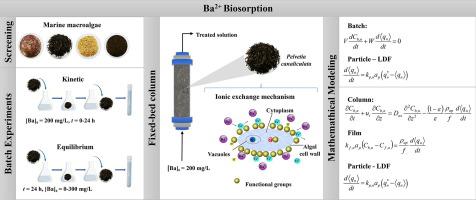Chemical Engineering Journal ( IF 15.1 ) Pub Date : 2020-06-26 , DOI: 10.1016/j.cej.2020.126019 Natália C. Fontão , Fabíola V. Hackbarth , Diego A. Mayer , Luciana P. Mazur , Antônio Augusto U. de Souza , Vítor J.P. Vilar , Selene M.A. Guelli U. de Souza

|
A mechanistic and phenomenological model for multi-component cation exchange has been applied in order to describe the dynamic behavior of barium removal by seaweeds in batch and fixed-bed systems, instead of the empirical models usually applied. Initially, four macroalgae were tested as natural cation exchangers for barium removal: Arribadas, Gracilaria birdiae, Pelvetia canaliculata and Sargassum cymosum. Brown alga Pelvetia canaliculata showed the highest barium uptake capacity, mainly associated with the amount of carboxylic and sulfonic groups present in the biomass surface. A mechanistic model based on the mass action law was able to predict the cation exchange equilibrium for the Ba2+/Ca2+/H+ multi-component system, being able to determine the selectivity coefficients between all ionic species for the functional groups. The Pelvetia canaliculata in the calcium form, after acid pre-treatment was used for fixed-bed column tests. The operating capacity was 1.85 mEq/g (237 BV), treating 14 L of influent (0.45 L/g of natural resin) until the breakthrough point. Elution in counter-flow mode, using 1.0 M HCl as eluent, was fast and efficient (100%), using only 5 BV of eluent (181 g HCl/L resin; eluant ratio of 520%). The mass transfer model proposed, considering equilibrium given by the mass action law, was able to predict well the ion exchange process in batch or continuous operation mode during the saturation and elution steps for all chemical species in the liquid and solid phase.
中文翻译:

使用海藻作为天然阳离子交换剂从水溶液中去除钡的数学模型迈出了一步:分批和固定床系统
为了描述分批和固定床系统中海藻去除钡的动态行为,已使用了用于多组分阳离子交换的力学和现象学模型,而不是通常使用的经验模型。最初,四种海藻进行了检验天然阳离子交换剂去除钡:Arribadas,龙须birdiae,Pelvetia福寿螺和蒿子荞麦。褐藻Pelvetia canaliculata表现出最高的钡吸收能力,主要与生物质表面中存在的羧基和磺酸基团数量有关。基于质量作用定律的力学模型能够预测Ba 2+的阳离子交换平衡/ Ca 2+ / H +多组分系统,能够确定所有离子对官能团的选择性系数。该Pelvetia福寿螺酸预处理后,以钙的形式进行固定床柱测试。操作容量为1.85 mEq / g(237 BV),处理14 L进水(0.45 L / g天然树脂)直至达到突破点。仅使用5 BV的洗脱液(181 g HCl / L树脂;洗脱液比率为520%),以1.0 M HCl作为洗脱液,以逆流模式洗脱可快速,高效(100%)。考虑到质量作用定律给出的平衡,提出的传质模型能够很好地预测液相和固相中所有化学物质在饱和和洗脱步骤中间歇或连续操作模式下的离子交换过程。


























 京公网安备 11010802027423号
京公网安备 11010802027423号